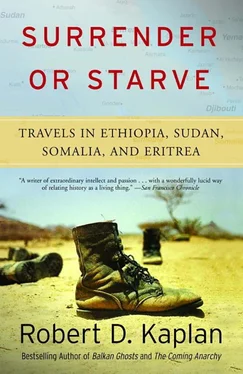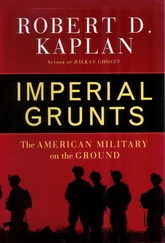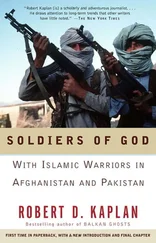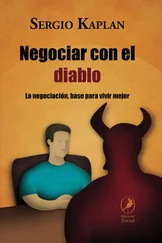The U.S. public was left only with images: of charming, suffering people, whose awesome physical beauty was being graphically savaged by what appeared to be an act of God. Drought, according to those first, memorable media reports, was the villain, and if anyone was to blame, it was the overfed West. Predictably, the Reagan administration caught more flak in the early stages of the emergency than did Ethiopia’s own government. Giving food, for individual U.S. citizens as well as for the administration, thus became a convenient means to expunge guilt. As the weeks wore on, however, the media began to paint a more complicated picture. Famine, it emerged, was not just an act of God, but an act of humans too. As more and more revelations came out about Ethiopian government misconduct, the U.S. public began to feel cheated; its penitent offerings of food were not really all that was required. By this time, however, the story was slipping away. The novelty value was gone. Other people and events were crowding in and competing for the sympathy and understanding of the U.S. television audience: hostages taken from a TWA plane in Beirut, blacks fighting for their freedom in South Africa, Nicaraguans reeling from the blows of repression and civil war. Just as the famine emergency was changing gears—moving from a charity issue to a deeply political issue—it began to fade. A fog of bewilderment remained.
The images on the television screen shocked, but they didn’t clarify. For all their horror, the images did not reveal to the U.S. public the intrigues and bloody conquests that were behind this suffering. Nor did the images reveal themselves as the result of Marxism and Amhara misanthropy. (Donald L. Levine, in his landmark study of Ethiopian culture, Wax and Gold, wrote that the Amhara “suffers from no illusions about homo sapiens at his best—unless they are dark illusions. …The generic word for ‘man’ in Amharic, saw, is the subject of a number of negative associations. …One may say that the Amhara’s view of human nature is dominated by his perception of man’s inherent aggressiveness and unworthiness.”) Thus, the U.S. public, sitting in front of television screens, was ignorant of the world from which the strange and disturbing images had sprung.
The Oromos stranded on the Somali plateau were but a symptom of their times. In the mid 1980s, Ethiopia evoked a scene out of Boris Pasternak; millions were displaced, often caught between rival armies, and on the move. They crossed a landscape of jagged mountain peaks and flaming sulfur deserts. In the extreme north, more than 150,000 Ethiopian army troops were battling 35,000 Eritrean guerrillas in a war that has witnessed the largest infusion of Soviet arms in all of Africa and—a few other cases aside—all of the Third World. In the neighboring province of Tigre, 15,000 self-declared Marxist rebels were fighting an insurgency against the government, which responded by burning crops and bombing village markets from the air. Other, smaller rebel outfits in Gondar, Wollo, and elsewhere also were tearing away at Mengistu’s army. According to Western diplomats, as quoted in a January 6, 1985, article in The New York Times by correspondent Clifford D. May, approximately twenty-five rebel organizations were active in Ethiopia. As a means to clear strategic swaths of the northern countryside of supposedly hostile concentrations of civilians, hundreds of thousands of highlanders were resettled in mosquito-infested swamps of the jungly southwest, where these highlanders were placed under the brutal supervision of Marxist cadres. Rather than risk being taken for resettlement at government feeding centers, hundreds of thousands of other famine-stricken people, mostly Tigreans, trekked westward for weeks on foot to refugee camps inside the Sudanese border. In southern Ethiopia, the Oromo Liberation Front (OLF) was active, which was one of several, obvious motives the government had for villagizing the Oromos. The 50,000 Oromos in Somalia were a fragment of that particular convulsion.
Ethiopia, when the U.S. television audience discovered it in late October 1984, was not so much a country as an empire in the throes of dismemberment. It had startling similarities with contemporary El Salvador and Afghanistan, not to mention Pol Pot’s Cambodia and the Soviet Union under V. I. Lenin and Joseph Stalin. Nevertheless, this age-old Christian-dominated state on the Horn of Africa had its own, grim method of dealing with its subjects: “surrender or starve.”
The spectacle of blood and starvation—a spectacle that is unprecedented, even by the inhuman standards of Ethiopia’s own past— continues to present the United States with one of its most compelling foreign policy challenges in the Third World since the start of the Cold War. Yet U.S. policy toward Ethiopia—massive grain deliveries notwithstanding—is as calcified as ever. The nationalist aspirations of the Eritreans are ignored, even though this is an underlying cause of hunger in the north of the country. The media, despite a surfeit of famine coverage, much of it repetitive, rarely reported in depth on official U.S. attitudes toward the nationalist aspirations of the Eritreans and other insurgent groups.
A hungry child may know no politics, as the U.S. government slogan proclaims, but politics—in Ethiopia and in the world at large—is really why that child is hungry. Every day, the gap widens between the number of people in Ethiopia and the amount of food produced there. Experts foresee a much greater famine in the 1990s. Aid is simply not effective in the face of regimes that do not have to ensure the well-being of their subjects in order to stay in power.
Less proximate than Nicaragua, less crucial than Iran (although just as populous), Ethiopia still remains one of the few big pieces that the USSR has managed to knock off the U.S. side of the board. Located at the entrance to the Red Sea through which more and more of the free world’s oil must pass, Ethiopia is truly strategic. Like Nicaragua and Iran, Ethiopia was lost while Jimmy Carter was president. The Carter State Department counseled restraint. After all, Moscow’s clumsy and brazen gambit to grab Ethiopia was certain to fail; unlike Iran, Ethiopia’s revolution was not anti-U.S. The Ethiopians, who never had been colonized, had a habit of ejecting foreigners and surely would want to do so again, so the logic of the liberals went. In a sense, they were right: Soviet influence is universally despised by the Ethiopian people. But even more so than in other places in the Third World, Ethiopia is a thugocracy: thugs run it, and only what they think and feel counts. The Soviets, therefore, were not ejected. To ever believe that they would have been was incredibly naïve.
Thugs get overthrown in Africa. Ethiopia, however, is different. Here the Soviets have implanted not only their influence, but their entire system and security apparatus as well. In the midst of the famine, with the media preoccupied with relief politics, Ethiopia converted its “provisional military” government to a “socialist democracy.” Socialist democracies are less easily dismantled. Cuba and Vietnam prove the point.
With grain alone, “you’re not going to charm a Stalinist oriented government out of its dependence on the Soviet Union,” the assistant secretary of state for African affairs, Chester Crocker, said to me. Although the Reagan administration was more realistic about Ethiopia than was the Carter administration, the former did precious little with its realism. If ever a Third World country were a candidate for the Reagan Doctrine, it was Ethiopia.
But Ethiopian politics plays to an empty house in the United States. There is no personality to capture the crowd’s attention. Lieutenant Colonel Mengistu Haile Mariam has proved himself to be more ruthless and more cunning than either Muammar Gaddafi or Ayatollah Khomeini. By the standards of several human rights reports, Mengistu is the world’s cruelest leader. But like many communist rulers, he is a faceless bureaucrat. The vast majority of the U.S. populace wouldn’t even recognize him.
Читать дальше












